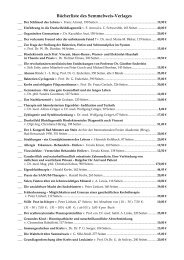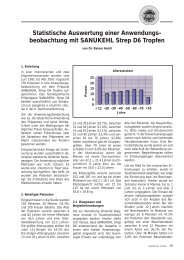Albicansan
Albicansan
Albicansan
You also want an ePaper? Increase the reach of your titles
YUMPU automatically turns print PDFs into web optimized ePapers that Google loves.
1 Introduction<br />
Between August 1991 and<br />
February 2001, a total number of<br />
285 patients in three medical<br />
practices, one specialising in internal<br />
medicine and two in general<br />
medicine, participated in an<br />
application study with the<br />
preparation series ALBICANSAN<br />
in the administration forms of<br />
capsules, drops, suppositories and<br />
injections. The homoeopathic test<br />
preparation, ALBICANSAN,<br />
consists (with respect to the different<br />
administration forms) of Candida<br />
albicans in the 3 rd , 4 th or 5 th decimal<br />
potency.<br />
ALBICANSAN D5 drops<br />
10 ml contain: 10 ml Candida<br />
albicans D5 dil. in accordance with<br />
provision 5a, HAB.<br />
ALBICANSAN D5 dilution for<br />
injection<br />
1 ml contains: 1 ml Candida albicans<br />
D5 aqueous dilution in accordance<br />
with provision 5b and 11, HAB.<br />
ALBICANSAN D4 capsules<br />
1 capsule contains: 330 mg Candida<br />
albicans D4 trit. in accordance with<br />
provision 6, HAB.<br />
ALBICANSAN D3 suppositories<br />
1 suppository contains: 0.2 g<br />
Candida albicans D3 trit. in<br />
accordance with provision 6, HAB.<br />
The aim of this application study<br />
was to determine the actual<br />
application of the preparation as well<br />
as its tolerance under the day-today<br />
conditions of a normal practice.<br />
It was also of importance to<br />
determine the acceptance of the<br />
preparation on the market,<br />
especially amongst children.<br />
Semmelweis-Institut GmbH<br />
In line with the study’s set-up, only<br />
descriptive statistical methods were<br />
used. The application of inductive<br />
methods was not indicated. An<br />
„intention-to-treat“ evaluation was<br />
carried out, i.e. that all those<br />
patients who had at least received<br />
one dose of the medicament were<br />
included in the study.<br />
2 Participating Patients<br />
285 patients participated in the<br />
study which comprised of 124 males<br />
(43.5%) and 161 females (56.5%).<br />
The age of the patients varied<br />
between 4 and 91 years, with an<br />
average age of 30.5 and a standard<br />
deviation of 20.6 years. The largest<br />
age group was that of patients under<br />
12 years (28.8% of all patients) and<br />
the second largest group was the<br />
one between 41 and 50 (17.2%).<br />
Almost of the same size were the<br />
groups between 13 and 20<br />
(14.4%), 21 and 30 (10.5%) and<br />
31 and 40 years (11.9%). 7.7% of<br />
all patients were between 51 and<br />
60 and 7.7% between 61 and 70,<br />
whilst only 1.8% were over 70<br />
years. Regarding age structure, the<br />
males with an average age between<br />
36.0 ± 21.2 were on average 10<br />
years older than the females with<br />
26.3 ± 19.0 years.<br />
Percent<br />
35<br />
30<br />
25<br />
20<br />
15<br />
10<br />
5<br />
0<br />
Age structure<br />
Height varied between 102 and 195<br />
cm with an average height of 157.1<br />
± 23.6 cm and weight was between<br />
15 and 100 kg with an average<br />
weight of 56.6 ± 22.0 kg.<br />
2.1 Diagnoses and<br />
Secondary Diseases<br />
The diagnosis leading to the<br />
prescription was to be entered in the<br />
study protocol. It showed that<br />
ALBICANSAN, according to<br />
Isopathy, was used in a very wide<br />
application range. The preferred<br />
application was independent of the<br />
patient’s age. The main indications<br />
were stomatitis, Perlèche as well as<br />
intestinal and skin mykoses. Vaginal<br />
mykoses were also indications in<br />
the adult age group. A diagnosis was<br />
made before the start and end of<br />
the therapy. Accompanying<br />
therapies were to be documented<br />
in the evaluation form.<br />
In order to obtain a measure of<br />
chronic diseases, the patients were<br />
asked in the study protocol how<br />
long they had suffered from the<br />
disease or complaints. Time frames<br />
were given of less than six months,<br />
up to one year, up to three years<br />
and more than three years.<br />
< 12 13-20 21-30 31-40 41-50 51-60 61-70 > 70<br />
Years<br />
Verlag für experimentelle Onkologie GmbH · 27316 Hoya · Germany -2-
















